If you’ve ever had possums nesting in your roof, you’ll know they can be noisy, messy, and hard to evict. In Australia, it’s illegal to relocate possums more than 150 metres from where they were found, and doing so can be harmful or fatal to the animal.
Rather than treating possums as pests, you can offer them a better alternative, right in your own backyard. Building a nest box provides a safe, natural home for native possums and helps keep them out of roof spaces and sheds.
By building a possum nest box, you can support native wildlife, encourage possums to stay out of buildings, and give them a safe shelter in increasingly urban environments. This guide walks you through everything you need to know to build and install a possum box.
@purpletreepets Only in Australia. Our roof guest thought he would say hello tonight. Probably should cover that back up. 😁#possum #brushtailpossum #australia #straya #onlyinaustralia #aussielife #aussie #aussiethings #aussiehumour #possumsoftiktok #cute #houseguest #unexpectedhouseguest ♬ original sound – australianmagpie
You can avoid this happening in your roof by creating a possum nesting box
What you’ll need
- Plywood (10–17 mm thick), untreated and weather-resistant (marine ply is ideal)
- Galvanised screws (better than nails for durability)
- Waterproof wood glue (PVA)
- Hinges for an opening roof lid
- Non-toxic paint in earthy colours like green or brown (for exterior only)
- Drill and jigsaw for holes and assembly
- Optional: rubber or metal flap for weather-sealing the lid
Avoid chipboard or treated pine, as these materials can be toxic or degrade quickly outdoors.

Box dimensions
These sizes are tailored to common Australian possums:
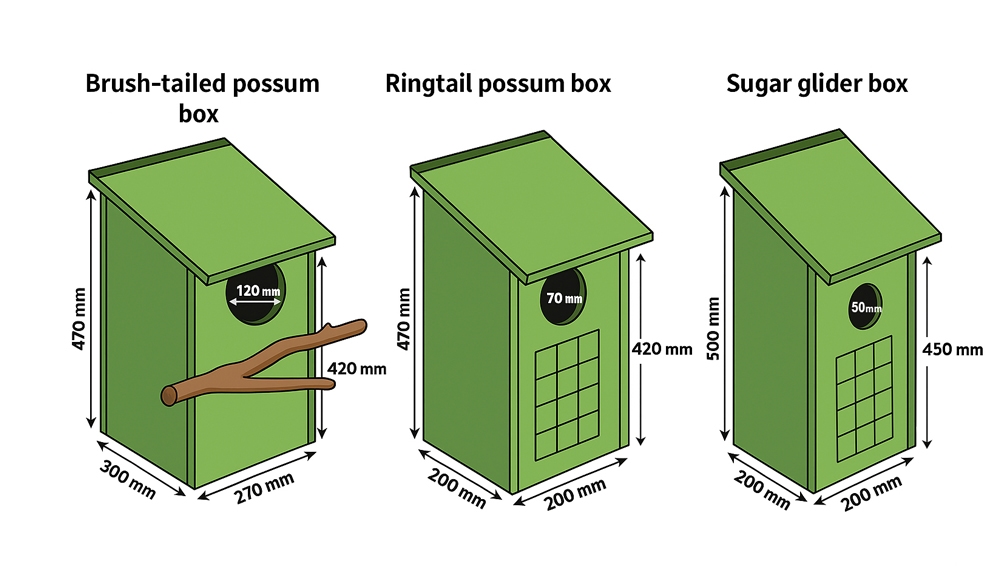
| Species | Height | Width | Depth | Entrance hole |
|---|---|---|---|---|
| Brush-tailed possum | 470 mm | 270 mm | 300 mm | 120 mm diameter |
| Ringtail possum | 470 mm | 200 mm | 200 mm | 70 mm diameter |
| Sugar glider | 500 mm | 200 mm | 200 mm | 50 mm diameter |
You can make boxes slightly larger but never smaller. Tight spaces can overheat or cause injury.
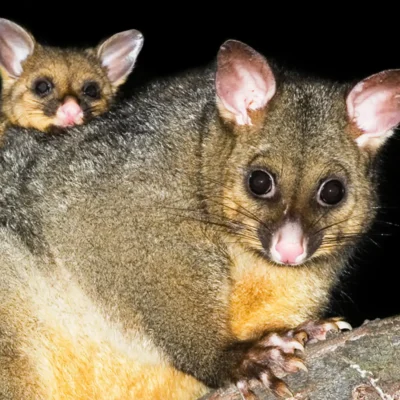
Brush-tailed Possum Nest Box
Materials:
- 12–18 mm thick untreated plywood or hardwood
- Non-toxic, water-based outdoor paint or sealant
- Galvanised screws, hinges, and brackets
Dimensions (Based on Updated Diagram):
- Floor: 300 mm x 270 mm
- Height: 470 mm
- Entry Hole: 120 mm diameter
- Entry Height from Bottom: 420 mm
Features:
- Sloped roof for water runoff
- External branch or dowel for easy access
- Hinged lid for monitoring and cleaning
- Ventilation holes near top
- Drainage holes in base
- Roughened inner walls or internal strip to assist climbing
Mounting:
- Height: 4–5 metres
- Secure to tree or pole from the back
- Orientation: Away from harsh weather (east or southeast)
Cute little brushtail possum residing in my roof space.
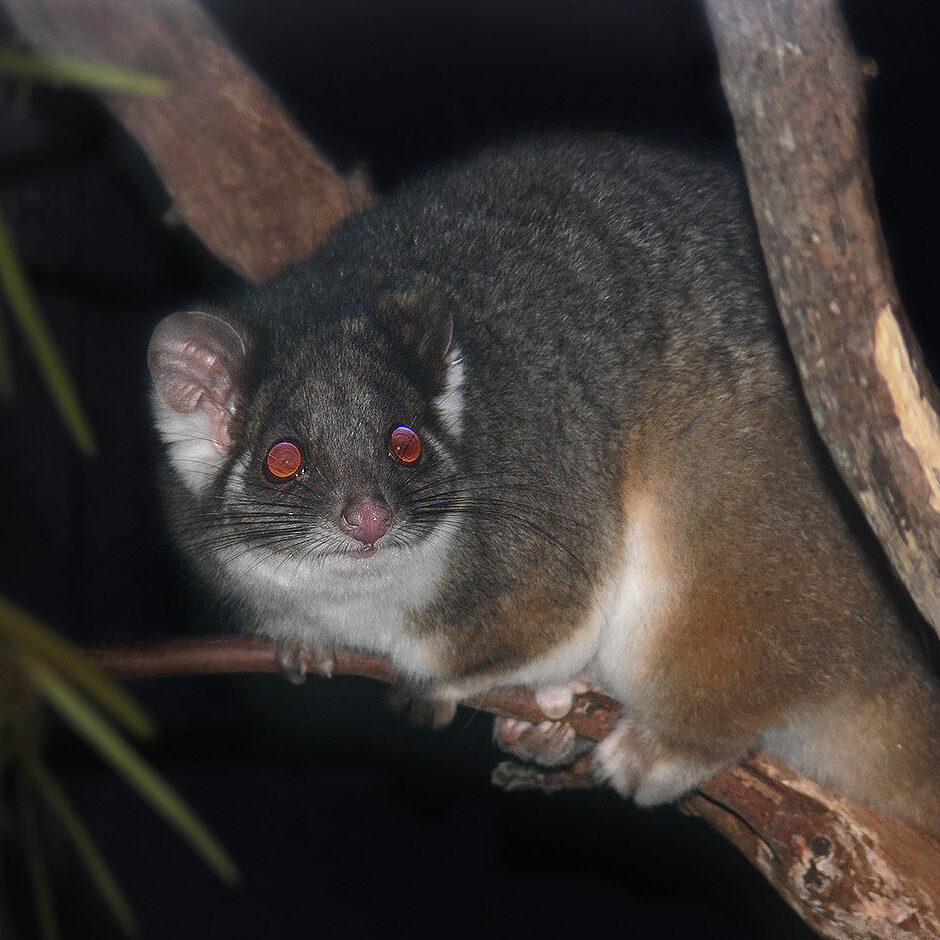
Ringtail Possum Nest Box
Materials:
- 12–18 mm plywood or hardwood
Dimensions (Based on Updated Diagram):
- Floor: 200 mm x 200 mm
- Height: 470 mm
- Entry Hole: 70 mm diameter
- Entry Height from Bottom: 420 mm
Features:
- Compact and suited to denser foliage
- Leaf litter inside
- Sloped roof and side grid pattern for climbing grip
Mounting:
- Height: 3–4 metres
- In dense shrubs or trees with foliage
- East-facing for weather protection

Sugar Glider Nest Box
Materials:
- 12 mm plywood or hardwood
Dimensions (Based on Updated Diagram):
- Floor: 200 mm x 200 mm
- Height: 500 mm
- Entry Hole: 40-50 mm diameter
- Entry Height from Bottom: 450 mm
Features:
- Sloped roof
- Small entry hole near the top
- Safe internal surfaces
- Nesting material (e.g. dry leaves) inside
Mounting:
- Height: 3–6 metres
- In clusters of 3–4 spaced 15–20 metres apart
- Position near food sources and gliding paths
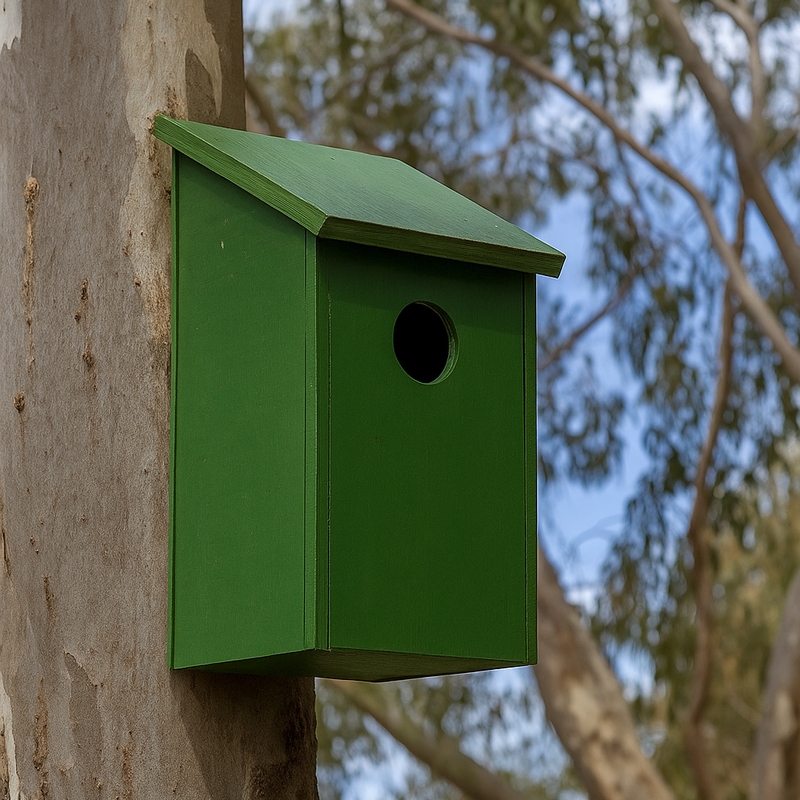
Construction tips
Roof design
- Overhang the roof by at least 110–120 mm to shield the entrance from rain
- Use hinges and a rubber flap to create a lid that opens easily for cleaning
- Sloping roofs are ideal for water runoff
Ventilation and drainage
- Drill 4–6 mm drainage holes in each corner of the floor
- Add small ventilation holes high on the side walls to prevent overheating
Interior
- Add a few handfuls of dry gum leaves or shredded paper as nesting material
- Roughen the inside front panel or add a small timber “ladder” strip to help young possums climb out
Entrance
- Drill the entrance hole on the front panel, about two-thirds of the way up
- For sugar gliders, place the hole slightly higher, as they glide in from above
- Attach a branch or stick just below the hole to help with entry
Add a baffle for added protection
A baffle is a vertical or angled panel installed above or around the entrance hole to help:
- Keep rain from entering the box
- Shield possums from wind and predators
- Reduce interior light and disturbance
Baffles are particularly useful for Brushtail and Ringtail possums. You can:
- Extend the front wall 100–120 mm above the entrance hole to act as a baffle
- Use a small piece of plywood attached at a slight angle above the entrance
- Ensure the baffle doesn’t block entry or airflow
The baffle can be painted the same colour as the rest of the box to maintain camouflage in trees or foliage.

Installation guide
- Choose box size based on species
- Ensure proper overhang and drainage
- Add entry perch and internal climbing surface
- Always pre-drill screw holes to avoid wood splitting
- Use rust-proof hardware
- Periodically check and clean the boxes (non-breeding season)
- Paint outer surfaces only
- Add bark or camouflage for natural integration
- Mount high and sheltered, with minimal predator access
- Mount the box 4–5 metres high on a tree, shed or pole, securely fastened with wire and hose sleeves (to prevent damage to trees)
- Position it away from prevailing wind and direct sun
- Angle the box slightly forward to keep rain out
- Trim nearby branches that might provide access to predators such as cats or large birds
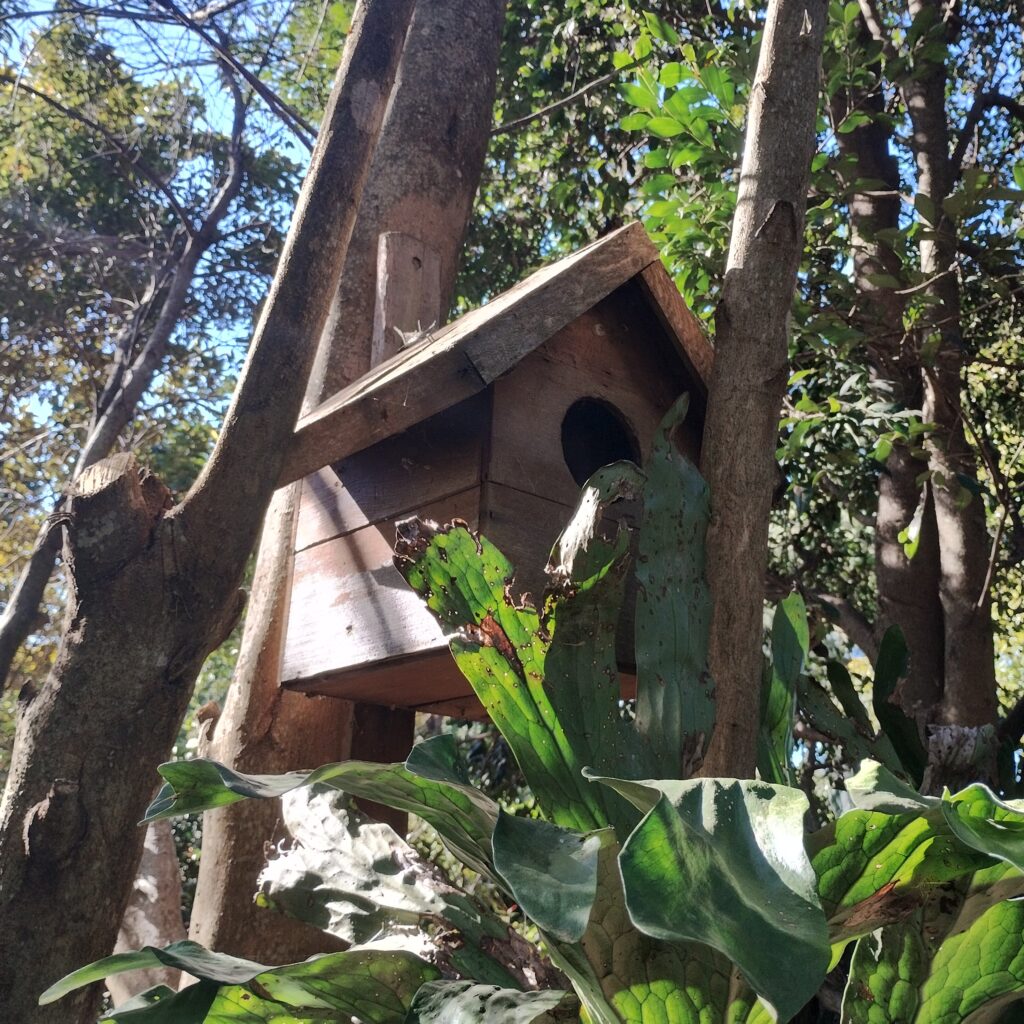
A multi-purpose nest box which may be inhabited by possums or parrots at Shoalhaven Heads Botanical Gardens, NSW.
Encouraging possums to move in
If you’re relocating a possum from your roof:
- Place some of their nest material (such as dried leaves or fur) in the new box
- Leave a treat like a slice of banana or apple inside to attract them
To gently deter them from returning to your roof:
- Block entry points once they’ve left
- Use strong smells (such as camphor or mothballs in containers) or motion-activated lights as deterrents

Maintenance
- Inspect every 6–12 months for damage or unwanted guests such as invasive birds
- Clean and refresh nesting material if needed, using gloves and avoiding disturbance
- Repaint the exterior every few years to protect the wood
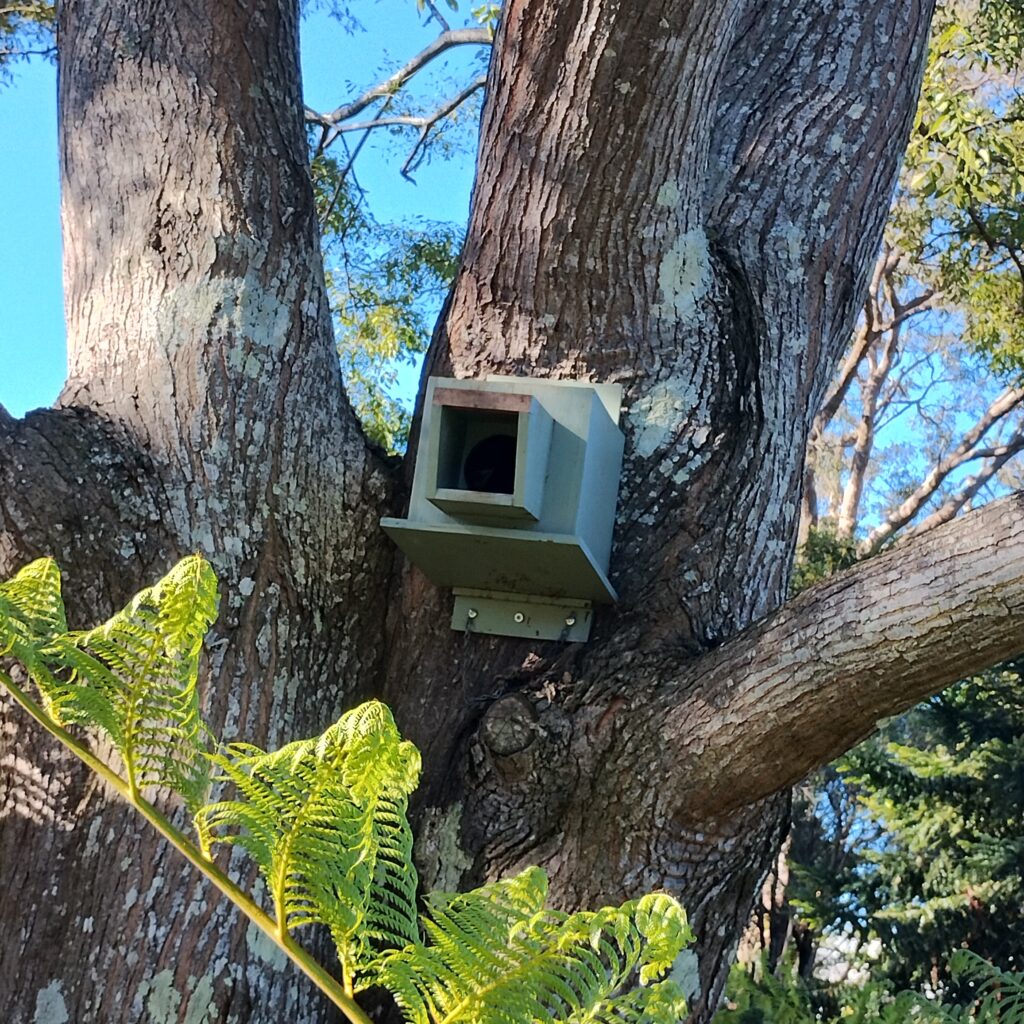
This nesting box has a protruding tunnel-style entrance which could be inhabited by possums or birds such as kookaburras. Located at Shoalhaven Heads, NSW.
Final thoughts
With a little effort, you can create a safe home for native Australian wildlife and reduce conflicts with humans. Possum boxes benefit not only possums but also our broader ecosystem by encouraging biodiversity in urban and suburban areas.
Plus, building one is a fun weekend project, especially for kids, families or community groups like Men’s Sheds.
If you aren’t able to make one yourself, websites like Nesting Boxes Australia sell pre-made possum boxes.

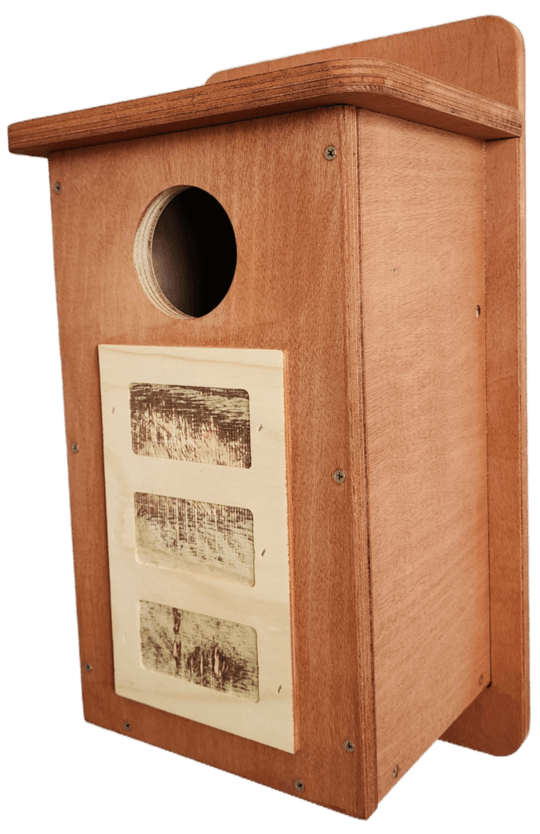
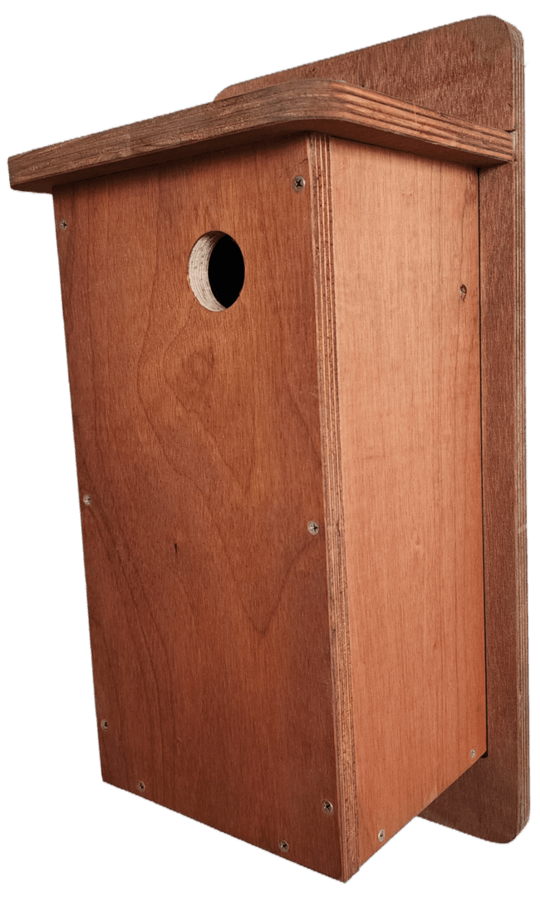
Shop : Nesting Boxes Australia
References & more information
- Wildlife Rescue South Coast DIY guide: https://www.wildlife-rescue.org.au/build-a-possum-box.html
- City of Ryde nest box PDF: https://www.ryde.nsw.gov.au/files/assets/public/v/1/environment/reen/past-meetings/reen-term-1-2018-build-a-nest-box.pdf
- NSW Environment nest box designs: https://www.environment.nsw.gov.au/sites/default/files/making-possum-house-nestbox-guide.pdf
- Nest box designs and species list:
https://nestboxtales.com/bushfire-zone-nest-box-design-and-species-list-booklets/ - Nesting Boxes Australia – Buy pre-made:
https://www.nestingboxes.com.au/








